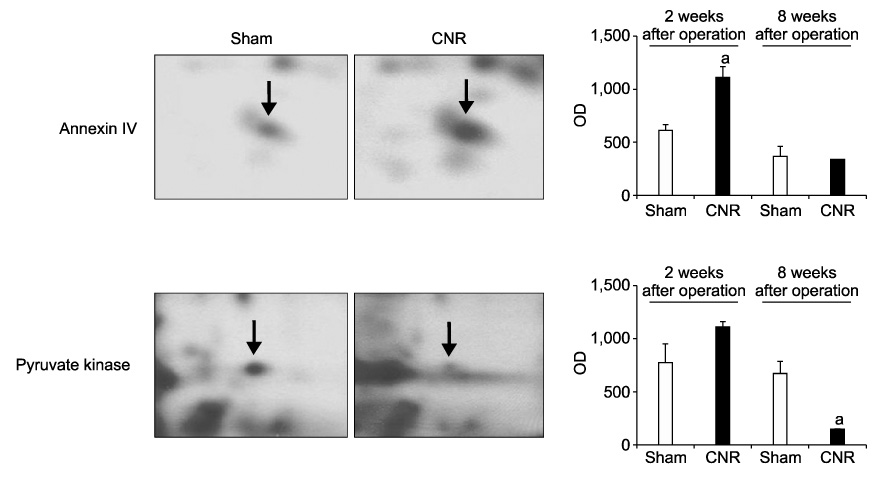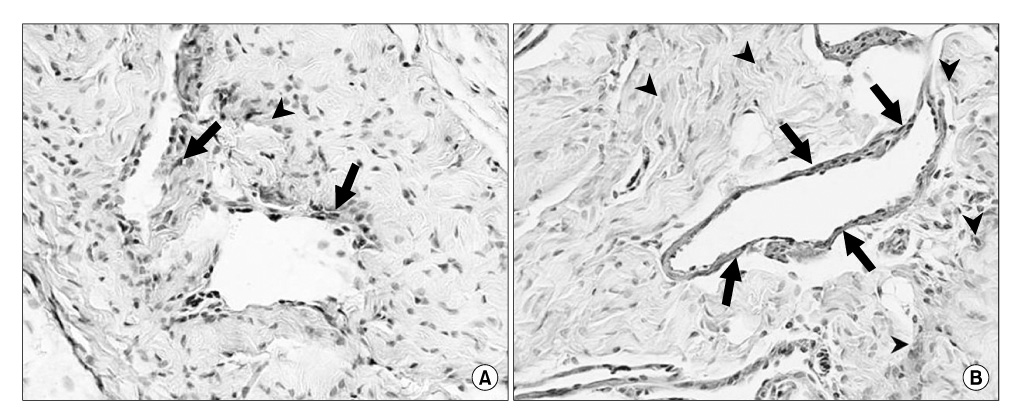Korean J Urol.
2009 May;50(5):498-504.
Proteomic Analysis of Penile Protein Alterations in a Rat Model of Cavernous Nerve Injury
- Affiliations
-
- 1Department of Urology, College of Medicine, Konkuk University, Chungju, Korea. yskurol@kku.ac.kr
- 2Department of Physiology, College of Medicine, Konkuk University, Chungju, Korea.
- 3Department of Obstetrics and Gynecology, College of Medicine, Konkuk University, Chungju, Korea.
Abstract
-
PURPOSE: Cavernous nerve resection (CNR) in rats is a standard model of animal experiments on erectile dysfunction (ED) that occurs after radical prostatectomy (RP). Injured cavernous nerves after surgery can cause fibrosis and apoptosis that lead to penile structural changes that may be accompanied by alterations of protein expression. This study aimed to analyze the changes in protein after CNR in Wistar Kyoto rats.
MATERIALS AND METHODS
Using 8-week-old male Wistar Kyoto rats, sham and CNR operation under a microscope were performed. Two and 8 weeks after surgery, we applied 2-DE and MALDI-TOF/TOF (AB 4700) to identify differently expressed penile proteins after CNR. 2-DE gels were stained with silver nitrate and were analyzed with PDQuest. After in-gel digestion, peptide mass spectra were obtained by MALDI-TOF/TOF mass spectrometry in the positive ion reflector mode. The obtained data were screened with a rat database from both the NCBI and the Swiss-Prot/TrFMBL home page.
RESULTS
The proteins that were changed more than 1.5-fold compared with the sham group were annexin A4 and pyruvate kinase (PK). Annexin A4 was increased by 1.75-fold after 2 weeks, whereas PK was decreased by 4.16 after 8 weeks. These results were confirmed by immunohistochemistry.
CONCLUSIONS
Annexin A4 in the CNR group was increased, which may be related to emiocytosis during apoptosis. The decrease in PK of the CNR group is assumed to be related to a decrease in efficacy during glycolysis. Further study will be needed to elucidate the molecular pathophysiology of ED after cavernous nerve injury.
Keyword
MeSH Terms
-
Animal Experimentation
Animals
Annexin A4
Apoptosis
Caves
Digestion
Erectile Dysfunction
Fibrosis
Gels
Glycolysis
Humans
Immunohistochemistry
Male
Mass Spectrometry
Prostatectomy
Proteins
Proteomics
Pyruvate Kinase
Rats
Rats, Inbred WKY
Salicylamides
Silver Nitrate
Annexin A4
Gels
Proteins
Pyruvate Kinase
Salicylamides
Silver Nitrate
Figure
Reference
-
1. Domes T, De Young L, O'Gorman DB, Gan BS, Bella AJ, Brock G. Is there a role for proteomics in Peyronie's disease? J Sex Med. 2007. 4:867–877.2. Burnett AL. Pathophysiology of priapism: dysregulatory erection physiology thesis. J Urol. 2003. 170:26–34.3. Liu X, Gao X, Pang J, Zhang Y, Wang K, Fang Y, et al. Proteomic analysis of rat penile tissue in a model of erectile dysfunction after radical prostatectomy. BJU Int. 2007. 99:1500–1505.4. Suter B, Kittanakom S, Stagljar I. Interactive proteomics: what lies ahead? Biotechniques. 2008. 44:681–691.5. Kim HJ, Youn WY, Myong NH, Hwang CH, Ryu JW, Lee YS. Proteomic approach for identifying marker proteins in the urinary bladder precancerous conditions induced by BBN (N-butyl-N-(4-hydroxybutyl) nitrosamine). Korean J Urol. 2004. 45:77–83.6. Shim JH, Kim HJ. Investigation of oxidative stress and development of lower urinary tract symptoms in the urinary bladder following partial bladder outlet obstruction by proteomic approach. Korean J Urol. 2005. 46:1337–1343.7. Kim HJ, Ryu YG, Hong JH, Hong JH. Proteomic analysis of the proteins that were changed by bilateral orchiectomy in the rabbit corpus cavernosum. Korean J Urol. 2008. 49:449–453.8. Ferrini MG, Kovanecz I, Nolazco G, Rajfer J, Gonzalez-Cadavid NF. Effects of long-term vardenafil treatment on the development of fibrotic plaques in a rat model of Peyronie's disease. BJU Int. 2006. 97:625–633.9. Nolazco G, Kovanecz I, Vernet D, Gelfand RA, Tsao J, Ferrini MG, et al. Effect of muscle-derived stem cells on the restoration of corpora cavernosa smooth muscle and erectile function in the aged rat. BJU Int. 2008. 101:1156–1164.10. Domes T, De Young L, O'Gorman DB, Gan BS, Bella AJ, Brock G. Is there a role for proteomics in Peyronie's disease? J Sex Med. 2007. 4:867–877.11. Bivalacqua TJ, Purohit SK, Hellstrom WJ. Peyronie's disease: advances in basic science and pathophysiology. Curr Urol Rep. 2000. 1:297–301.12. Leungwattanakij S, Bivalacqua TJ, Usta MF, Yang DY, Hyun JS, Champion HC, et al. Cavernous neurotomy causes hypoxia and fibrosis in rat corpus cavernosum. J Androl. 2003. 24:239–245.13. Dubbelman YD, Dohle GR, Schröder FH. Sexual function before and after radical retropubic prostatectomy: a systematic review of prognostic indicators for a successful outcome. Eur Urol. 2006. 50:711–718.14. Lee JW, Kim CS, Ahn H. Early and late complications of radical retropubic prostatectomy. Korean J Urol. 2000. 41:1409–1414.15. Monastyrskaya K, Tschumi F, Babiychuk EB, Stroka D, Draeger A. Annexins sense changes in intracellular pH during hypoxia. Biochem J. 2008. 409:65–75.16. Piljic A, Schultz C. Annexin A4 self-association modulates general membrane protein mobility in living cells. Mol Biol Cell. 2006. 17:3318–3328.17. Barwise JL, Walker JH. Annexins II, IV, V and VI relocate in response to rises in intracellular calcium in human foreskin fibroblasts. J Cell Sci. 1996. 109:247–255.18. User HM, Hairston JH, Zelner DJ, McKenna KE, McVary KT. Penile weight and cell subtype specific changes in a post-radical prostatectomy model of erectile dysfunction. J Urol. 2003. 169:1175–1179.19. Lysiak JJ, Yang SK, Klausner AP, Son H, Tuttle JB, Steers WD. Tadalafil increases Akt and extracellular signal-regulated kinase 1/2 activation, and prevents apoptotic cell death in the penis following denervation. J Urol. 2008. 179:779–785.20. Ferrini MG, Kovanecz I, Sanchez S, Umeh C, Rajfer J, Gonzalez-Cadavid NF. Fibrosis and loss of smooth muscle in the corpora cavernosa precede corporal veno-occlusive dysfunction (CVOD) induced by experimental cavernosal nerve damage in the rat. J Sex Med. 2009. 6:415–428.21. Gonzalez-Cadavid NF. Mechanisms of penile fibrosis. J Sex Med. 2009. 6:Suppl 3. 353–362.22. Patriarca A, Eliseo T, Sinibaldi F, Piro MC, Melis R, Paci M, et al. ATP acts as a regulatory effector in modulating structural transitions of cytochrome c: implications for apoptotic activity. Biochemistry. 2009. 48:3279–3287.
- Full Text Links
- Actions
-
Cited
- CITED
-
- Close
- Share
- Similar articles
-
- Penile erection evoked by autonomic nerve stimulation in rats
- Down-regulation of Dopamine D1 Receptor in Rat Penile Tissue after Cavernous Neurotomy
- Differential Expression of Proteins Related with Penile Apoptosis in a Rat after Cavernous Nerve Resection
- Argonaute 2 restored erectile function and corpus cavernosum mitochondrial function by reducing apoptosis in a mouse model of cavernous nerve injury
- Photobiomodulation as a Potential Therapy for Erectile Function: A Preclinical Study in a Cavernous Nerve Injury Model




